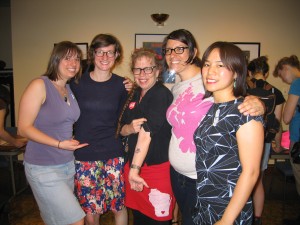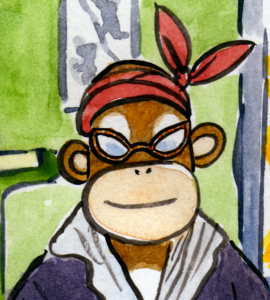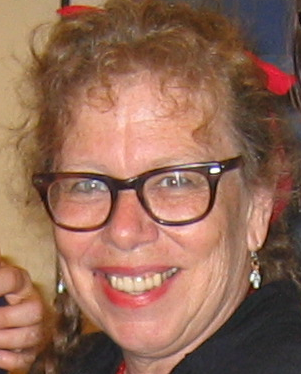Lynda Barry Loves Librarians: Part II
Lynda Barry discusses teaching at the University of Wisconsin-Madison, e-books and Asian American readership.
by Dawn Wing
Lynda Barry is a cartoonist, author, playwright, teacher and library aficionado. In 2009, she won the Wisconsin Library Association: Literary Award and the Eisner Award for her book What It Is. Her works of fiction and comics include Cruddy, Ernie Pook’s Comeek and One! Hundred! Demons! In One! Hundred! Demons!, Barry uses vivid imagery and words to bring to life an “autobiofictionalography” of experiences such as her Filipino upbringing and the growing pains of childhood, adolescence and friendships.
In Spring 2012, Lynda Barry was the Artist-in-Residence at the University of Wisconsin-Madison where she taught “What it is: Manually Shifting the Image.” She had her students (including me) refer to her as “Professor Lynda.” Currently, Professor Lynda is teaching a course called “The Unthinkable Mind” at UW-Madison.
Below is an abridged and edited version of an interview I had with Professor Lynda discussing the role of picture books libraries and librarians in her life. The interview took place on August, 30th, 2012 at City Bar in Madison, WI.
The first part of the following interview is available in the Winter 2012 issue of the APALA newsletter.

Dawn Wing (DW): In the class you taught during Spring 2012 at UW-Madison, “What it is: Manually Shifting the Image,” you emphasized the importance of reading stories we wrote aloud. Why do you think hearing a story read aloud is important?
Lynda Barry (LB): I think our brain is developed with this – our way of understanding the world is through story and metaphor – so if you think about stories came first, libraries became as a home for a lot of stories, fiction and non-fiction – But I think there is something about reading aloud – and if I had had the kind of parents that kids seem to have today, you know, to take you to story time at the library – and have that long tradition of sitting on another person’s lap with a book in front of both of you – it’s almost like when you jump off a plane with a parachute, you jump with somebody – you jump to this ability.
I was never read to at all, and I still find it to be this astonishing thing. And the cool thing about technology right now is there are more opportunities for people to hear stories read aloud whether it’s live, somebody talking or you have a choice, maybe driving into work, where you can listen to stories being read aloud. And that didn’t happen when I was younger. It could’ve happened on a piece of vinyl somebody read – the 100 vinyl set, you know.
So there’s something about hearing that read aloud – but especially hearing it read aloud at the library where it’s kind of this event, and I’m always really surprised when I’m at the library and there’s a story thing going on, I’m really surprised at how the kids are able to concentrate – you don’t think they would. Some of them don’t, but a lot of them do. And how much they like to make books.
DW: What are your thoughts on the book as a physical object versus e-books which are now becoming the trend?
LB: I think that there’s nothing like the frigate like a book. Was that Emily Dickinson?
I think it is. I think that there is a completely different experience of the book as a physical object even to the point where you know you are in the book. Like I’m half-way through, 3/4 of the way through – I think on Kindle or e-books, something’s really lost. Something’s gained because you can just pop it in your pocket. I have people tell me, “Oh, I have 400 books on this.” It’s like “Yay, that’s great. Here’s my little thumb drive and I have 400 songs. Ok, it’s like make ’em play by doing what?”
It’s like this weird thing, but then again book as objects, I’ve always collected books. I have tons of them everywhere so it’s sort of that same thing: I have 400 books. I’m probably as likely to read all of them as the person who has them downloaded to their Kindle. But, I think for kids in particular there’s something about turning a page, pointing to the different stuff.
I wasn’t able to finish reading it, but there was an article I ran into today right before I left about actually touching the paper with your finger that that really helps people learn how to read and write. You know this pointing thing and touching. It turns out that touching those words – there was some study done that something about actually touching them with your finger. So I know that that can happen and it’s all going to go touch-screen – it’s already in that direction.
But I just think there’s something about paper and it’s going to be that thing when TV came and people who were really attached to radio talked about TV taking something away. And those of us who grew up with TV were like, “Pff, whatever it was I don’t miss it.”
And I think there’s something about books that that will be – even in my town now – Janesville – it’s a pretty significant sized town, there’s not one bookstore. So libraries are really going to be it. Libraries and online ordering. And that’s going to be it. That’s going to be where you find the books.
So, I also think that kids – it’s all the difference in the world when you’re making a book by hand, using your little stapler and drawing than designing a page on the computer.
They both have wonderful things about them. In my eyes, I love that with a book, you can be in any position that you want. You don’t have to be making your body accommodate the thing that you’re looking at. Although you can with a Kindle, I’ve never read anything on a Kindle.

DW: How has your work been received by the Asian American community when it became popular and available through the public library? Were people excited?
LB: Well, not in my family. But that’s my family. But for instance, the first time I wrote about being Filipino was in “100 Demons” and that was on Salon originally – it was a web comic. But since then, and that came out in 2002, I think – so it’s 10 years. Wherever I go, there’s always someone who comes up and a lot of times it’s a mixed person like me, a hapa, talking about how huge it was to just see someone speaking Tagalog in a comic strip. So that’s been gigantic. I’ve met more 1/4 Filipinos (I’m 1/4 Filipino) who look like me like you kinda look at their face, they look like they’re white but they’re not – something’s going on.
And whenever I tell people I’m part Filipino, then especially Filipinos, they’ll go (in Filipino accented English) – “I can see it a little bit in the earlobes, and hair. Oh, I can see it.”
So that’s been a really big deal and I know that’s been even in my own family – seeing a Filipino on TV, this was in the 60s, would just make everyone run to the television to see it.
The Asian community in general, we were relegated to Uncle Ben’s converted rice, not even Uncle Ben’s, it was some other rice thing- you know where they always play a gong -poor Uncle Ben, he’s not even Asian and he has to deal with converted rice – he’s converted. But you know that whole Asian thing where you only come on for one reason -so I think that’s been a big deal. And I think that’s a point of pride for me. It is. It means a lot to me.
My grandma, her ability to read was kinda limited. I think she could read, but not very well though. But she could speak English, Spanish, Tagalog and Bisayan . And she was a really really smart lady.
So that’s very interesting – three generations – to go from reading and writing were not part of the daily life to that’s all I do now. But I have to say it wasn’t a big deal in my family and it still isn’t. They weren’t readers. They did other things. There wasn’t a whole lotta interest in school. Me going to school when I went to college that was just like why?
Which is really different from a lot of other Asian cultures. Filipinos are really interesting that way because other cultures, man, you had no choice. You’re going. And you’re going to study us worth paying for. So that part’s sorta interesting.
To read previous parts of this interview published in January 2013, please visit: http://www.apalaweb.org/wp-content/uploads/2013/02/APALANewsletter_Winter2012v31-2-1.pdf
For more about Lynda Barry’s work, visit:
Lynda Barry’s Tumblr –http://thenearsightedmonkey.tumblr.com
“The Unthinkable Mind” @ UW-Madison –http://theunthinkablemind2013.tumblr.com

